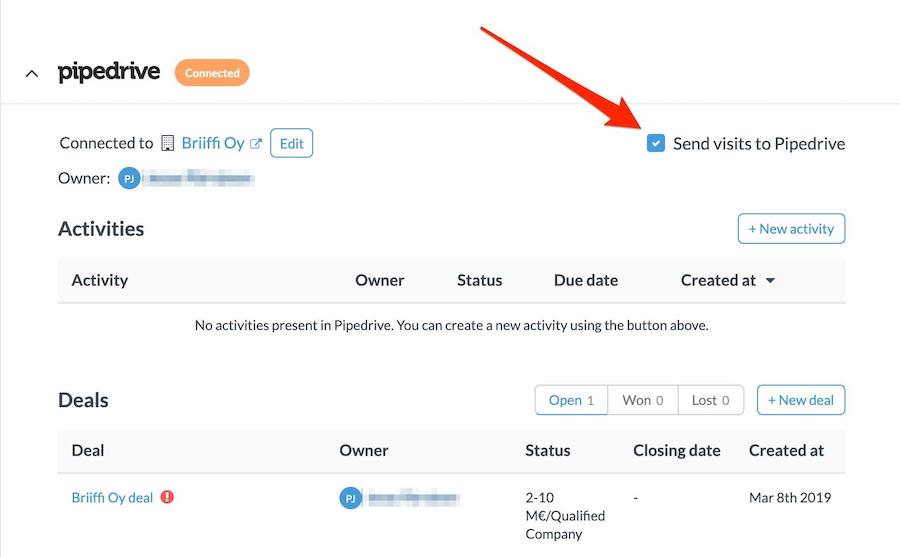Before we started Leadfeeder back in 2012, we were running our previous web analytics startup, helping B2B companies analyze their website traffic and where it was coming from.
While we were doing that, we noticed that most salespeople and marketers were spending a lot of time in the dark.
They were making cold calls, creating content, and sending emails blindly—with no visibility into what prospects were interested in or how their efforts affected behavior and engagement.
Specifically:
They didn’t know when clients showed interest by visiting the website
They didn’t know how engaged leads were or what they were interested in.
They didn’t have the data to personalize their efforts or figure out what worked (and what didn’t) to move leads through to a sale.
So, we thought to ourselves, “Can we fix this?”
What if sales and marketing teams knew when leads visited their website?
What if they knew what pages they visited and what they were interested in?
What if they could pull that data from Google Analytics without code or scripts?
What if they could pull that data from with our own code without Google Analytics?
Could we build a website visitor tracking tool that did this and would connect with sales and marketing tools they were already using (like HubSpot, Salesforce, Pipedrive and MailChimp)?
Below, I'll talk about the best B2B website visitor identification software, Leadfeeder:
Note: Spending your time in the dark? Leadfeeder’s B2B website visitor identification software shines a light on prospects visiting your website. You can try Leadfeeder free for 14 days here.
We also realized that existing methods to access that information left a lot to be desired:
They were so complicated and technical that only a developer could deploy them—sales and marketing teams just weren’t going out of their way to get this done.
They isolated and siloed data in their own system. We noticed sales and marketing teams really relied on Google Analytics, so first, we built our tool to work on top of Google Analytics. Then, created our own tracking script without Google Analytics for better data quality.
They didn’t fit into the daily lives of the marketers and salespeople the products were supposedly built for.
We knew how valuable visitor identification could be for B2B lead generation, so we sought to build a solution that would solve the pains of existing website visitor identification tools, and finally give marketers and salespeople easy access to powerful data.
Once we saw everything the current website visitor identification market lacked, we asked ourselves:
What makes the best B2B website visitor identification software?
What would we want in one?
Building the best B2B website visitor identification software
At Leadfeeder, we want to give our customers the information they need as quickly as possible, as easily as possible, using the data that already exists.
That’s why everything we do at Leadfeeder circles back to one tenet: context.
We’re here to help make marketing and sales teams as intelligent as they can be, and that comes down to offering people insights, not just data.
For us, that distinction comes down to context.
Website visitor identification data shouldn’t be siloed or scattered across a dozen tools that don’t work together—it should be connected and enable you to see the whole picture, instead of a single data point.
When marketers and salespeople can see the context behind numbers, that data becomes easier to use, act on, and connect with other data and tools they use every day.
That idea crystallized into three big attributes we knew we’d want in our own website visitor identification software:
Easy and quick to set up, with access to retroactive data to provide immediate results.
Insights to bring intelligence to the age-old sales process.
Integrations to plug visitor identification data right into existing sales and marketing tools.
Making it easier to access website visitor identification data
One of the biggest problems we saw with the landscape of B2B website visitor identification software is how data is accessed.
Many tools require marketers and salespeople to install a script on their website or follow some other complicated process to get their website visitor tracking data.
When you’re looking for software to make your work and life easier, the last thing you want is hurdles right out of the gate.
Our solution was to build Leadfeeder on top of something nearly every marketer knows and has access to: Google Analytics.
We saw two huge benefits from that decision:
You can set up a Leadfeeder account instantly, just by connecting our software to an existing Google Analytics account.
You have access to meaningful, usable data from day one—because all of that information is already living in Google Analytics.
Soon after we established a tool that integrates with Google Analytics, we created our own tracking script called Leadfeeder Tracker (previously known as Booster).
We offered it as an upgrade. The Leadfeeder Tracker gathers data 24 times a day, compared to Google Analytics previously twice a day.
Plus, as a first-party tool, we have higher-quality data.
This was a smart decision on our part because, in February 2020, Google Analytics removed the Networks Report that we used to pull information.
Helping sales processes catch up with marketing technology
Another thing we noticed when starting Leadfeeder was that sales technology was lagging behind the advancements in marketing technology.
Marketing technology has evolved rapidly over the last decade.
From email marketing automation to marketing analytics and intelligence, the industry looks completely different than it did in the not-so-distant past.
But on the sales side, there hasn’t been such a radical development.
Today, salespeople still get to the office, fire up their CRM, and start dialing—the same as they did 10 years ago.
So, we saw a sales process ripe for change.
Salespeople need the intelligence and context to know who to call, when to call, and what messaging will resonate with prospects.
That’s why we focused on building a tool that works with CRM software and prospecting tools.
Building software that fits into the lives of salespeople & marketers
The last problem we wanted to address with our tool wasn’t restricted to being a website visitor tracking software. It’s an issue endemic to many a failed technology—they don’t fit into people’s lives.
At the end of the day, all the data in the world isn’t useful unless salespeople and marketers can access it without hassle or extra steps.
Data isn’t all that actionable unless it:
Comes to you automatically
Works with your other data
That’s why we added two key Leadfeeder features: new lead notifications (for both email and Slack) and two-way integrations with popular CRM systems.
We want the data salespeople get from Leadfeeder to work together with all the other information they have access to, so we built a CRM integration that goes both ways.

Leadfeeder doesn’t just send leads to your CRM—it also pulls data from your CRM into your Leadfeeder dashboard, which lends even more context to your visit data.
That means our software can be an integral part of both lead generation and lead nurturing processes, helping salespeople to:
Identify individual visitors by their company and send potential leads to their CRM.
Discover the right messaging to convert existing sales leads and upsell existing customers.
Customize Slack and email alerts, so you know the right time to follow-up.
Everything lives together, so salespeople can get a holistic and complete picture of both new and existing leads.
Leadfeeder is the best B2B website visitor identification software
Here at Leadfeeder, we’ve seen both our software and the visitor identification industry grow significantly over the years.
Throughout, we’ve kept actionability and context at the core of every product development decision—that’s a big part of why we believe Leadfeeder is the best B2B website visitor identification software available today.
Since we were voted as a G2 leader in our category, our customers seem to think so, too.
Note: Spending your time in the dark? Leadfeeder’s B2B website visitor identification software shines a light on prospects visiting your website. You can try Leadfeeder free for 14 days here.
Get more from your web analytics.
t’s time to turn your website traffic data into something more meaningful. Website visitor analytics enable you to identify and qualify the companies visiting your website, even when they don’t fill out a form.
Show me how




